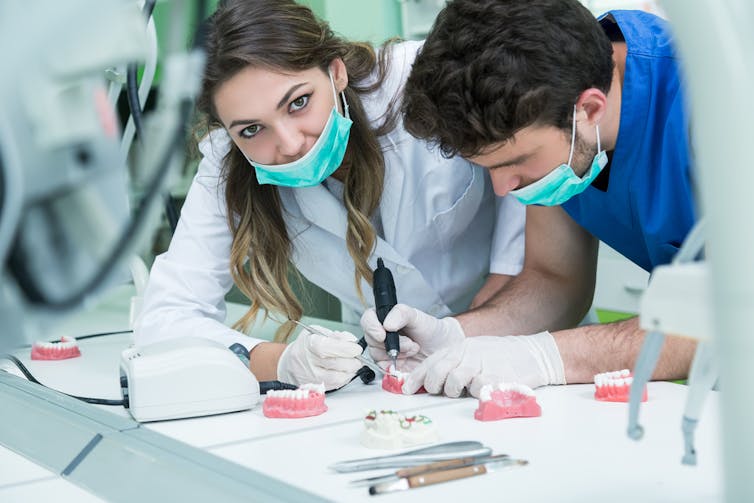
Universal and affordable access to dental care is the perennial health-care issue everyone cares about but no major political party seems willing to address in any substantive way.
Thank goodness the Greens consistently remind us of the pressing need to make dental care an essential part of health care. This election, they’ve been quick to push out their policy to integrate dental care into Medicare.
They propose everyone with access to Medicare be eligible for what are described as the “clinically relevant services they require”. This includes general dental, orthodontics (such as braces) and restorative services (such as crowns).
To make sure there are enough dental professionals, the Greens propose university education and training for the dental workforce be fee-free.
Such an expansive scheme is very expensive. This has been costed at A$77.6 billion over the next decade, funded with new taxes on big corporations and billionaires.
The Greens (who might hold some sway in a new parliament but will never be in government with budget responsibilities) have the luxury of proposing a large-scale program with no information about its presumable gradual introduction.
The Greens have also proposed a funding mechanism that is very unlikely to fly, given both the Coalition and Labor view new taxes and tax reforms as political poison.
The Greens’ publicly available policy document is just three pages long and very short on detail. A number of key questions go unacknowledged and unanswered.
Read more: Voters love the Greens' message more than ever – but it may not lead to a surge of votes for them
How much will this cost?
The policy has been costed by the independent Parliamentary Budget Office, so there must be more detail available about the program’s rollout and scope.
The policy document does not say if the proposed $77.6 billion investment includes, or is in addition to, current federal spending on dental care through the Medicare-funded dental services for eligible children, public dentistry for some adults, and GP and hospital visits for dental needs.
This figure likely does not include the costs of free university education for dentists, which is part of the Greens’ separate education policy.

This $77.6 billion investment over ten years is substantial. This equates to an average of $7.7 billion a year – about the same (see table 5.8.1) as the annual cost to the federal budget of the subsidy to encourage people to purchase private health insurance.
However, these costs should be balanced against the economic benefits a federal government investment in a universal dental-care program would deliver in terms of reduced health-care costs and increased productivity.
What is covered?
The proposal is said to be costed on the basis that 80% of dental services will be “routine”. But especially in the early years of such a program, there will be a pent-up demand from people who have waited years for care. These people will need more extensive and expensive services.
Formal guidelines about what is “routine” or “essential” and a focus on prevention and early intervention will be critical to ensure targeted care and prevent cost blow-outs.
Read more: Two million Aussies delay or don't go to the dentist – here's how we can fix that
The workforce
Having the right dental workforce in the right places is essential for universal access to dental care.
Simply providing free university places for dental students will not address the current situation, which sees a surfeit of dentists in metropolitan areas and a scarcity in rural, remote and socially disadvantaged areas.
Many dental-care services can be delivered by dental hygienists and technicians and any new scheme should encourage the most appropriate professional to deliver each service.
Read more: How to brush your teeth properly, according to a dentist
What is missing?
The policy does not specifically address providing oral health and dental care for people with special needs, including aged-care residents or people with a physical or mental disability.
The campaign materials talk about “free dental care” but provide no indication as to how this will be achieved. Under Medicare, neither the fees doctors and allied health professionals charge, nor bulk billing, are mandated. It would be very difficult to impose set fees and a requirement to bulk bill on dental professionals.
Read more: The shocking state of oral health in our nursing homes, and how family members can help
First steps
For too many years, I and others have been writing about the need to address oral health and dental care.
University of Sydney colleague Professor Heiko Spallek and I recently proposed that in the face of unwillingness of the major political parties to implement a universal dental-care program, there should be a more targeted approach to providing dental services.
For example, this could be a preventive program for children, oral hygiene programs for people in aged care, Medicare coverage of dental care for pregnant and post-partum women and for people with certain chronic medical conditions, such as cancer, diabetes or HIV/AIDS. Alternatively, a more limited approach could see the provision of designated essential services under a means-tested program.
I’ve written before about the need for teams of dental professionals and educators where they’re most needed, such as remote and under-served communities.
Read more: How to fill the gaps in Australia's dental health system
It’s important to start the debate
Dental health has a huge impact on people’s quality of life. This includes health outcomes, self-esteem and employability.
But for too many Australians, the burgeoning out-of-pocket costs of private dental care and long waiting lists for publicly-funded care are a major barrier.
It is time for politicians and the medical profession to see oral health and dental care as an essential health-care issue worthy of substantial investment.
The Greens’ proposal – despite its inadequacies – has a vision that should serve as a starting point for public debate.
Lesley Russell does not work for, consult, own shares in or receive funding from any company or organisation that would benefit from this article, and has disclosed no relevant affiliations beyond their academic appointment.
This article was originally published on The Conversation. Read the original article.







